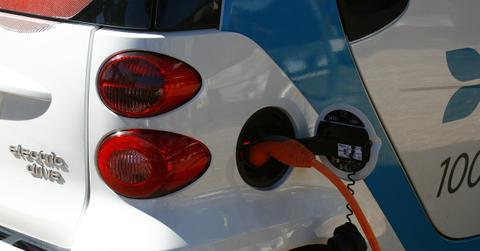Is The Power Grid Ready For Electric Vehicles?
A nuclear power plant in the United Kingdom could be old hat by the time it's completed thanks to electric vehicles and their potential energy demand. This could also mean a trying time when switching to renewable sources, but there are ways to control it.
Updated May 24 2019, 9:29 a.m. ET
When the automobile market becomes flooded with electric vehicles, will our power grid be able to handle it? Recent predictions over in Europe show that demand could surpass capacity should owners not be charging their vehicles during off-peak times. Do utility companies have the ability to adapt for the future of EVs?
Adam Vaughan of The Guardian approaches the subject by noting that electric vehicles could reach nine million units by 2030. That’s 100 times the amount of EVs currently traveling around in the United Kingdom. It could spell disaster for the Hinkley Point C nuclear power plant that’s currently under construction should consumers not charge their vehicles “smartly.”
How do you charge an EV “smartly?” By plugging it in at times when the power grid isn’t being bogged down by other users. This can vary by location, but a variety of daytime hours during the weekdays are usually in the peak timeframe. Most of the time, nights, weekends, and holidays are all considered off-peak. Estimations by National Grid show that up to eight gigawatts could be used during high demand periods by 2030.
This is a big issue for the already controversial nuclear power plant. The capacity is expected to reach 3.2 gigawatts, but it’s not expected to be online until 2027. That’s a 15-month delay from prior estimations and it will cost over $1.74 billion US more. EDF said these adjustments were necessary after further evaluation of construction and regulations. By the time this plant is done, it could already be outdated in terms of backing up other sources of energy.
Utility companies will do their best to shift around electricity usage. Many corporations abide by demand response management systems. This process temporarily shuts off electricity for a period of time to take a load off of the electrical grid, which would cut costs and could provide financial rewards. They can also receive incentives to build renewable energy sources or battery storage during the times they aren’t live on the network.
The process of transitioning to more renewable energy could also create disruption in the electrical grid. It’s still widely inefficient and if there isn’t proper storage by the time EV demand rises, there will be even more reason to keep traditional power plants online. However, a unique aspect to think about is every EV is a smaller-scale battery storage solution.
Could there be a way to share this electricity without a hitch? Possibilities are endless at this point. There would obviously be credit given for pushing more energy back into the grid, and there will likely be monitoring apps available so the vehicle won’t be completely zapped out of electric fuel.
We can’t predict what technology will come out in the future, but there will more than likely be additional ways to control energy usage in the future. Business are continuing to push for less energy usage and residents are doing more to control their own power. The rise of EVs are certainly something to be concerned about, but there will be solutions to keep the grid from being hampered.
